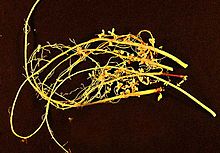
Back ريزوبيا Arabic Клубеньчыкавыя бактэрыі Byelorussian Rizobi Catalan Knoldbakterie Danish Rizobio Spanish ریشهزیست Persian Rizobio Galician 根粒菌 Japanese ରାଇଜୋବୀୟ OR Bakterie brodawkowe Polish

Rhizobia are diazotrophic bacteria that fix nitrogen after becoming established inside the root nodules of legumes (Fabaceae). To express genes for nitrogen fixation, rhizobia require a plant host; they cannot independently fix nitrogen.[1] In general, they are gram negative, motile, non-sporulating rods.
Rhizobia are a "group of soil bacteria that infect the roots of legumes to form root nodules".[2] Rhizobia are found in the soil and, after infection, produce nodules in the legume where they fix nitrogen gas (N2) from the atmosphere, turning it into a more readily useful form of nitrogen. From here, the nitrogen is exported from the nodules and used for growth in the legume. Once the legume dies, the nodule breaks down and releases the rhizobia back into the soil, where they can live individually or reinfect a new legume host.[2]
- ^ Zahran, Hamdi Hussein (1999-12-01). "Rhizobium-legume symbiosis and nitrogen fixation under severe conditions and in an arid climate". Microbiology and Molecular Biology Reviews. 63 (4): 968–989, table of contents. doi:10.1128/MMBR.63.4.968-989.1999. ISSN 1092-2172. PMC 98982. PMID 10585971.
- ^ a b Herridge, David (2013). "Rhizobial Inoculants". GRDC.